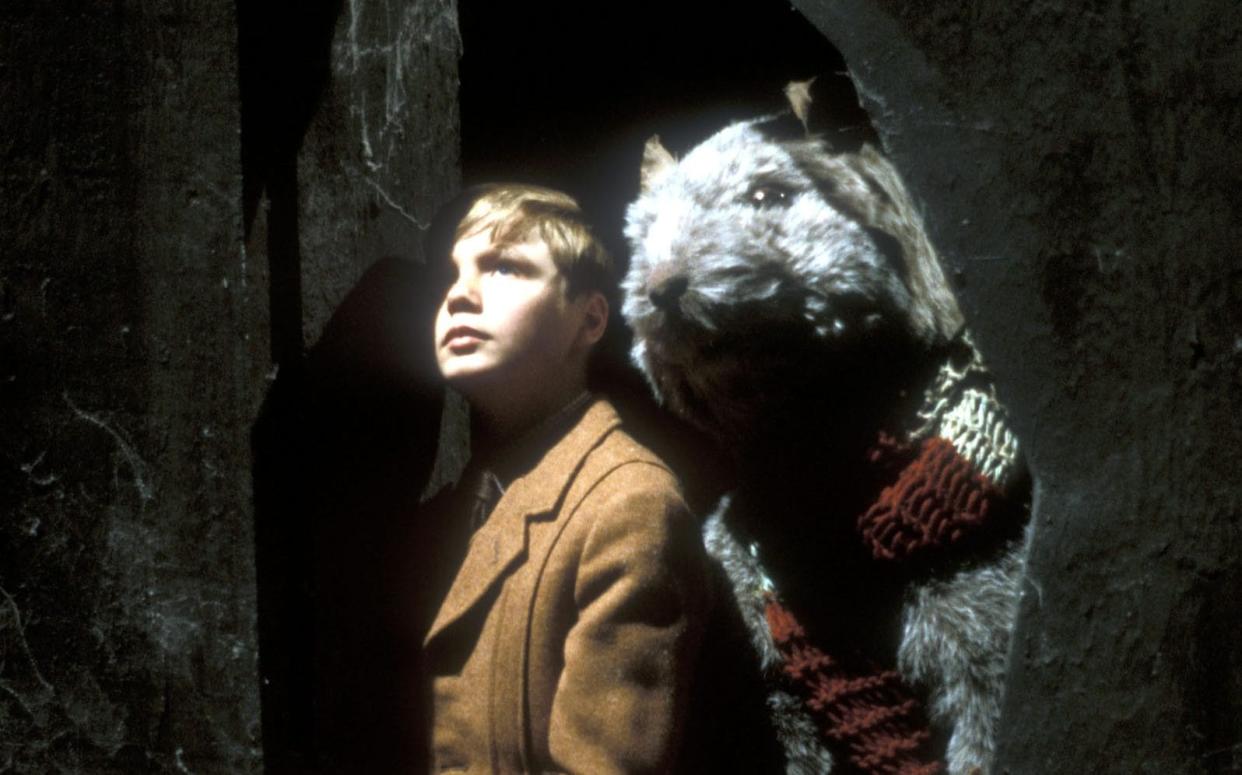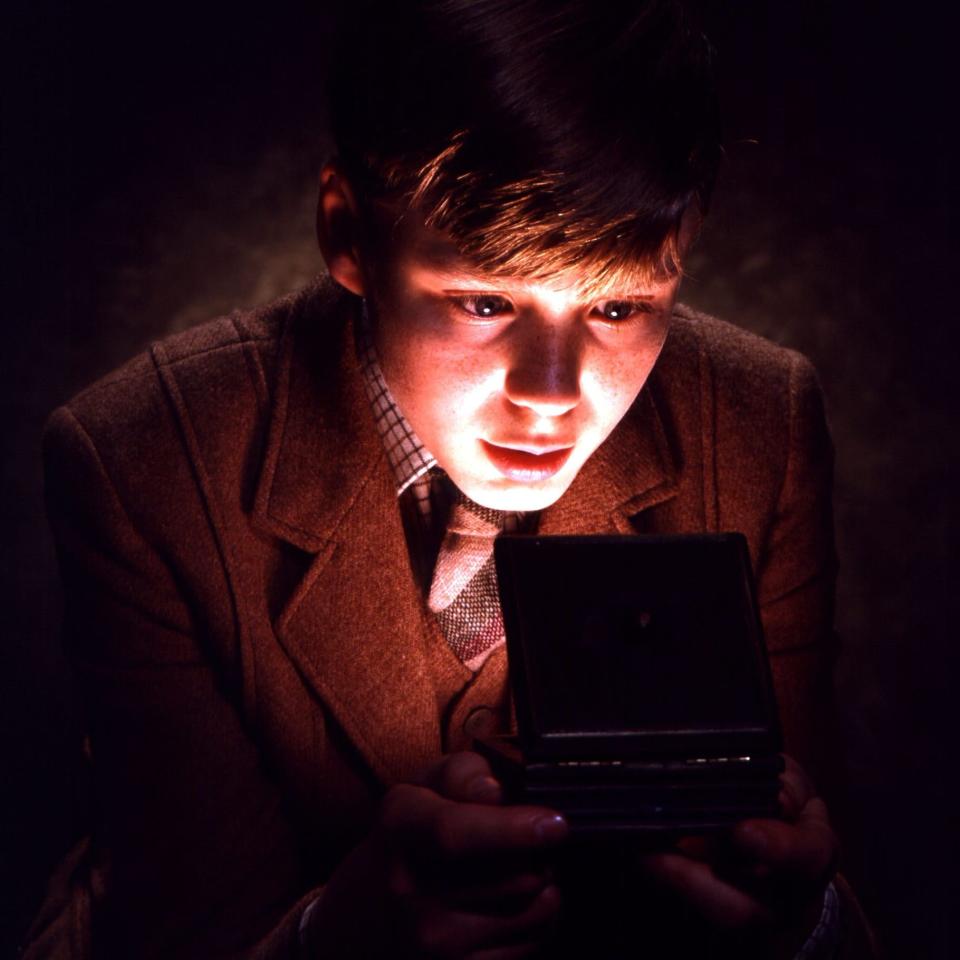Inside The Box of Delights: 'You'd never have JK Rowling without John Masefield'

- Oops!Something went wrong.Please try again later.
- Oops!Something went wrong.Please try again later.
Director Renny Rye recalled feeling “terror” at the prospect of directing The Box of Delights. Adapted from the classic children’s novel by John Masefield, it was (by BBC standards in 1984, at least) a lavish, technically ambitious series: at the time, the BBC’s most expensive ever children’s series. “Every page you turned in the script and the book had yet another fantasy,” said Rye in a 2004 interview. “It was quite a challenge.”
Devin Stanfield, who played Kay Harker – schoolboy adventurer and wielder of the tricksy box – recalls filming the sequence that best captures the magic of the series. After jumping astride a (flying) pony, Kay soars into the air, leaving behind the relative normality of 1934, and lands in a burning, Arthurian encampment, where he fights off wolves with a sword, battling the beasts alongside King Arthur himself.
“I was obsessed with swords and stage fighting,” says Stanfield about his 12-year-old self. “As soon as they gave me that sword for the sequence with the wolf, I remember Renny Rye saying, ‘Rein it in please! Stop looking so gleeful… you’re supposed to be scared, not filled with bloodlust!’ ”
Indeed, The Box of Delights is real boys’ adventure stuff, sprinkled with fairy dust and wrapped in the Christmassy comforts of old-school BBC production. It’s a world of plummy-mouthed kidspeak (“splendiferous!”); where itching powder is a form of torture; and the baddies drive a car than turns into a aeroplane.
But the generation of kids who watched The Box of Delights over Christmas 1984 may also have unnerving memories of it: human-sized rat-men, a devilish villain in clergyman’s robes, and the tinkering terror of its theme tune – a variation of The First Noël.
In the story, Kay Harker travels home for Christmas and meets wizened Punch and Judy man Cole Hawlings (Patrick Troughton). Hawlings entrusts Kay with the Box of Delights, which has magic powers (thanks to ancient wizardry and the BBC’s blue screen-enhanced special effects). It can, among other things, transport its owner to magical worlds, send them back in time, or shrink them to Borrowers size. Kay and his chums must stop the box from falling into the hands of evil magician Abner Brown (Robert Stephens) and cronies.
John Masefield’s original book was published in 1935, a sequel to his 1927 novel The Midnight Folk. Dr Philip W Errington – a Sotheby’s book specialist and Masefield expert – has written Opening the Box of Delights, which explores the history of the story. He credits Masefield and The Box of Delights with inspiring a movement in 20th-century children’s fantasy. “It predates Tolkien and it predates CS Lewis,” says Errington. “I would claim you’d never have JK Rowling without John Masefield.”

The BBC first adapted The Box of Delights for radio in 1943. It was produced for BBC radio again every decade until the TV adaptation, and one final time in 1995 (starring the young Alastair Sooke – now the Telegraph’s chief art critic – as Kay).
“I think The Box of Delights really does belong to the BBC,” laughs Errington. “It’s been a perennial favourite. I would say the crowning glory is the TV adaptation.”
To get it made, producer Paul Stone had to fend off competition from a potential Hollywood version. (Later on, around 2009, another big-screen adaptation was mooted, to be directed by Mike Newell, but didn’t get off the ground either.) Australian playwright and author Alan Seymour adapted the story for TV. It cost £1 million to produce, with a £135,000 investment from Lella Productions, a Christian company in the US. According to Errington, it came at a time when the BBC was looking into co-productions. By August 1984, Lella had sold the series to 215 Public Broadcasting Service stations in the US.
For Stanfield, who appears in most scenes – adventuring, flying, or eavesdropping on the baddies’ wretched schemes – it was a long, arduous production. “It was pretty grueling,” he explains. “It was a year of my life.”
The first location shoot was near Aberdeen, selected for its guaranteed snowfall. There was some panic when the snow didn’t come as expected; then, it snowed so heavily it delayed production. “They wanted six inches of snow – I think we had six feet,” recalls Stanfield. “There’s one scene where Crispin Mair [Kay’s pal Peter] and I are hiding in a ditch full of snow, watching some nefarious activities from the bad guys. You can see both of our teeth chattering. There was no acting involved. I was absolutely freezing.”
Stanfield recalls other less-than-magic moments: getting dunked into a canal at Dudley Castle (“We were endlessly being stuck in freezing cold water or freezing cold snow”); sweating in front of blue screen (“I was in a tweed suit and under heavy studio lights… It was tortuous actually”); and having to ride bareback after he’d exaggerated his horse-riding skill level to the production crew (“There’s a shot whether the horse is running on ice… you can see the back legs skitter as the horse nearly goes!”).
Stanfield, now 49, works in production management and carpentry for theatre and TV. He never planned to pursue an acting career; an agent friend put him on the books. Stanfield found himself starring opposite two British acting greats: Patrick Troughton and Robert Stephens.
Much like his Doctor Who, Troughton beams with warmth as Cole Hawlings. “Those scenes where I’m up close to Patrick Troughton and he’s delivering his mystical, strange ramblings,” says Stanfield, “I remember feeling this sense of being slightly hypnotised. He was a very charismatic presence when he turned it on.”
Across six episodes, Troughton’s scenes are relatively few. The powerhouse performance belongs to Robert Stephens as the evil Abner Brown. When trying to coax Stephens into playing the role, Rye went to panto at the National Theatre, where Stephens was playing an Ugly Sister. Stephens arrived in the bar in full costume and make-up, and greeted Rye with a kiss on the lips. But Stephens, who died in 1995, was an actor of heft and gravitas. Even in the dafter scenes of his scheming in The Box of Delights – arguing with a come-to-life bronze head, or bullying a painted-green imp – he’s otherworldly sinister.
“His performance is just on the edge of going over-the-top but not quite,” says Phlip Errington. “It’s what you want from Abner. If you watch his eyes, he’s sometimes looking elsewhere in the room. There’s this sense that something else is going on in his head. His acting ability is incredible.”
Arguably, the star attraction was the special effects: a blend of live action and animation, and (now primitive-looking) blue screen. See Kay joining Herne the Hunter in the fantastical Wild Wood and turning into a stag (Ian Emes’ animation is still sumptuous); or sailing across the waters in a Tron-like sequence.
“I remember on lunch breaks going up to the VT rooms,” says Devin Stanfield. “Tripods, the John Christopher adaptation, was shooting at the same time, and they were trading show reels, because they were using new special effects as well. There was a competitive thing of ‘What have they done? What are they doing?’ Even as a child I sensed there were these new toys, and the techie boys were excitedly playing with them and exploring the possibilities.”
The show was broadcast between November 21 and December 24, 1984. It was repeated for Christmas 1986 and had several VHS releases, making it a British Christmas tradition. Errington still rewatches it with his children.
Watched now, the seams of the special effects and costumes are easy to spot. It’s dated, but timeless. The real delight is its warming, off-kilter nostalgia. Like the miniaturised kids, it’s still easy to get lost in the wonder of its fantastical worlds, characters, and animated interludes.
“It’s stayed in the public consciousness,” says Devin Stanfield. “People have a great fondness for it. It tapped a nerve.”
Opening the Box of Delights by Dr Philip W Errington (Darton, Longman & Todd) is out now

